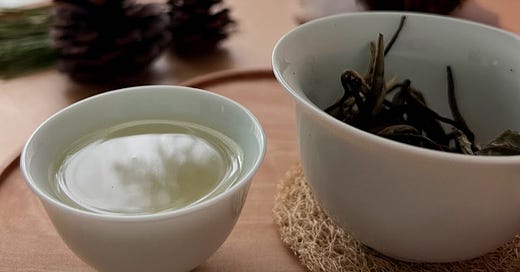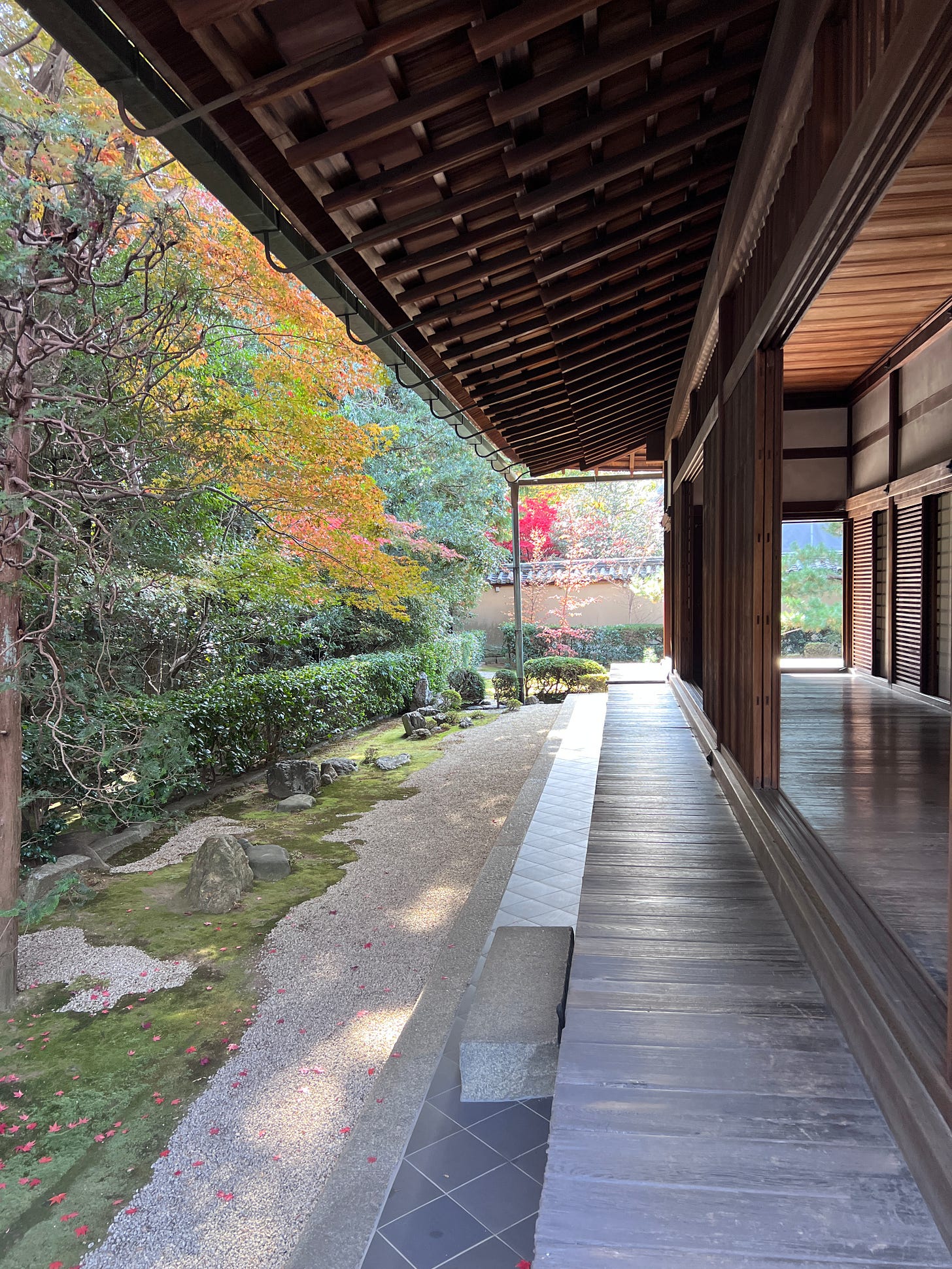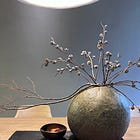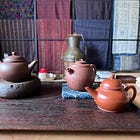小雪: 橘始黄 / Lesser snow: Tachibana citrus tree leaves start to turn yellow (72 microseasons)

茶, the Chinese and Japanese Kanji character for tea, is made up of 3 radicals: 艹 on top (grass), 人 in the middle (human), 木 at the bottom (trees). Combined, the three radicals of 茶 signifies human’s relationship with nature 人在草木间.
三才盖碗 Sancai gaiwan, the Chinese lidded tea bowl, is made up of 3 parts: the lid as heaven 天, the cup in the middle represents humanity 人, the saucer as earth 地. Put together, the three components signify the unity between heaven or nature and humans 天人合一.
From tea leaves to tea tools, we are an integral part of nature.
“Tea is not just about the drink,” as Dairik Amae, Japanese tea master in the Way of Tea, remarked. In Zen Tea 禅茶, one takes on a meditative and mindful attitude of serving: for Buddha, for others, for ourselves. Tea is also a gateway to spirituality, the connection encompassing the spectrum between body, mind, and spirit.
For not nature only but man’s being has its seasons, its sequence of spring and autumn, summer and winter. - Chuang Zi and Hui ZiTaoism and Tea 茶道
Tea has a close relationship with Buddhism, Confucianism, and Taoism.
But the relationship between Taoism and tea is the least talked about. Almost nobody knows Taoism (Daoism).
In Taoism philosophy, there is this foundational concept of naturalness 自然 as detailed in Chapter 25 of Tao Te Ching. See interpretation in Taoism Reimagined by
.
「人法地,地法天,天法道,道法自然」Man models himself after the Earth; The Earth models itself after Heaven; The Heaven models itself after Tao; Tao models itself after Nature. - translated by Lin Yu Tang,《道德經》第二十五章
Naturalness in Taoism refers to self nature. Living in harmony with the Tao 道 or the way, following the natural order of the universe, and trusting nature.
In Laozi’s Tao Te Ching and Zhuangzi’s parables, we see key concepts that resonates with tea culture, such as simplicity, emptiness, tranquility, seclusion, independence of thought, playfulness, wuwei 無爲 or effortless actions, following the natural rhythm of life (上善之人,如水之性 Highest good is like water).
Who can (make) the muddy water (clear)? Let it be still, and it will gradually become clear. - Tao Te Ching, Chapter 15Taoist alchemy practice focuses on longevity and immortality. From tea preparation to enjoyment, tea is a drink for health promotion. The energy of tea 茶气 can be used to purify and harmonize one’s body, mind, spirit for health and spiritual attainment.
One of the earliest records between the tea 茶 and tao 道 connection was written by a Buddhist monk and poet, Jiaoran 皎然 (730–799) in a poem called 'A Song of Drinking Tea to Chide the Envoy Cui Shi' 饮茶歌诮崔石使君:
孰知茶道全尔真,唯有丹丘得如此 Drinking tea makes you fully understand the true nature of Cha Dao, only Dan Qiuzi, the Taoist immortal, knows the best.
Photos by me. See Instagram | See LinkedIn | See previous posts | About
Tang Dynasty, Taoism, Zen
唐煮, 宋点, 明泡 - During the Tang Dynasty, tea culture was first cultivated with the boiling of salt, ginger, and compressed tea cakes made up of green tea leaves.
Tea was first recorded in ‘The Classic of Tea’ 《茶经》by Lu Yu 陸羽. It tied drinking tea to spirituality, including the concept of frugality and rustic simplicity or 儉 jian. For Lu Yu, tea symbolized the harmony and mysterious unity of the universe. Drinking tea with a peaceful mind is a way of drinking tea and a way of life to achieve physical and mental harmony.
In the Tang Dynasty, Boddhidharma brought Buddhism from India to China. It is said that Bodhidharma attracted only one disciple (Hui Ke), a Taoist.
Eventually, the Chinese Linji School of Ch’an Buddhism 禅 (which later became Zen in Japan) was founded by 臨濟義玄 Linji Yixuan through the blending of Mahayana Buddhism and Taoism.
“The Buddha Dharma is also in the Way of Tea”.
In Japan, during the 15th century, under the inspiration of Ikkyu (famous Zen Master), tea drinking became a means to Zen, not through words but at an experiential level.
It is said that Ikkyu then inspired his disciple Murata Juko who went on to establish the first Japanese wabi-cha or chanoyu or tea ceremony.
At Shinju-An in Daitoku-ji 大德寺珍珠庵, the 15 placed stones in the Eastern Garden arranged in 7-5-3 sequence is attributed to Murata Juko. His teachings on tea were then passed on to Takeno Joo and Sen no Rikyu, renowned for perfecting the Japanese tea ceremony.
“The closeness to nature that Zen absorbed from Taoism is represented by the wabi-sabi elements. Things that have matured or aged in harmony with nature and are beyond man’s control.” - Zen at Daitoku-ji (1974) by Dr Jon Covell and Abbot Yamada Sobin
“He who had made himself master of the art of living was the Real Man of the Taoist… He is unassuming, like a piece of wood not yet carved; vacant, like a valley; formless, like troubled waters."
- The Book of Tea by Kakuzo Okakura (1906)Song Dynasty and Taoism
During the Song Dynasty, tea drinking was further popularized with powder-grounded tea leaves for whisking (which then evolved and refined to what we now know as matcha in Japan). And in the Ming Dynasty, brewing loose-leaf teas became the norm that we have become accustomed to.
Emperor Song Hui Zong 宋徽宗 heavily promoted Taoism during the Song Dynasty. As with many other ancient cultured predecessors in the East, he was multi-talented in tea, arts, poetry, painting, calligraphy, and music.
Often demonstrating Taoist leanings in his work, we see in his calligraphy brushstrokes how he had challenged the conventional aesthetics through his ‘slender gold’ style of calligraphy with movement, grace, and speed.
Emperor Song Hui Zong loved tea immensely so much so that he personally ground his own tea. He wrote the ‘Treatise on Tea’《大观茶论》and co-painted Wen Hui Tu 文会图 to portray Court Tea Ceremony. The Treatise on Tea described the art of whisked tea known as the Seven-Boil Whisked Tea Method 七湯點茶法.
「此自布茶」Here is my own expression of the tea ritual: how I am in tea.
But his final years were brutal with his capture (as well as his family and the entire royal court) by the Jin Army and death in Manchuria while in exile.
And thus, the start of Yuan Dynasty.
A cup of tea. Our journey back to nature.
The warming of tea bowl - a connection intertwined with the past and the thousand years of legacy.
Each leaf. The slow unfurling of tea leaves in hot water - flowing through time in memorial, to the sacred tea trees first discovered by our ancestors (legend has it that Shen Nong discovered tea in 2737 BC).
Each sip, grounding us to the present moment. From the whispers of wind and roots entwined.
Each drop, we touch the whole of time - a return to nature, a journey back in time. Where time dissolves, where moments converge. A timeless flow in every drop.
Returning to nature, returning to me. A conversation with nature.
Photos by me. See Instagram | See LinkedIn | See previous posts | About











心静茶味香
Is a phrase I like. I read it as ‘When the heart/mind is quiet/still, the tea will taste’
心静 is pointing at the spiritual body
茶味香 is pointing at the physical body
A lovely history of tea culture.